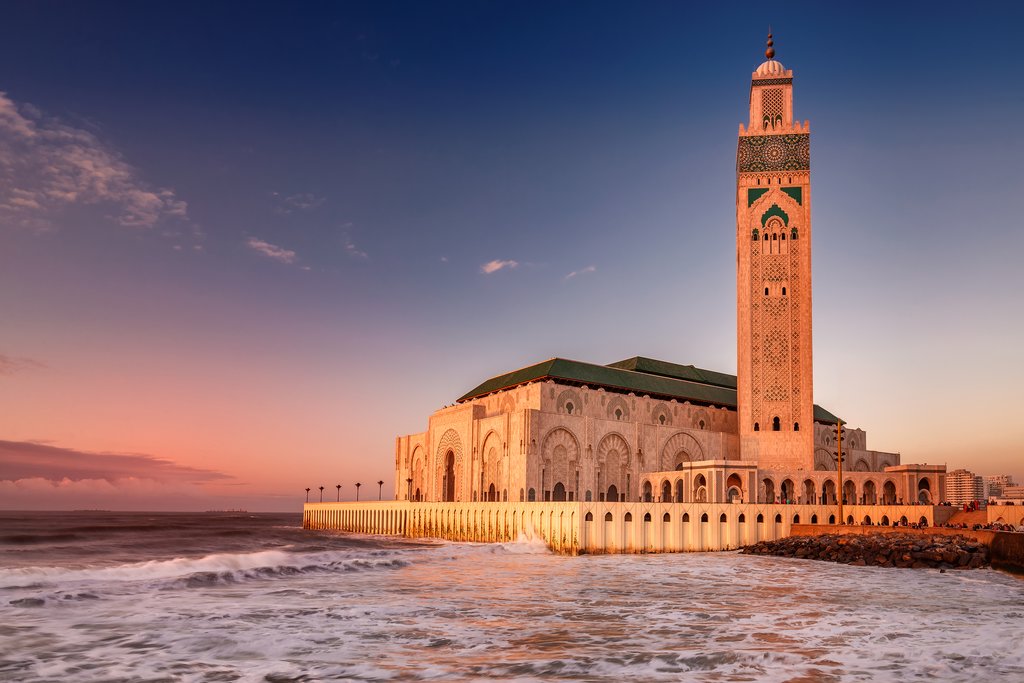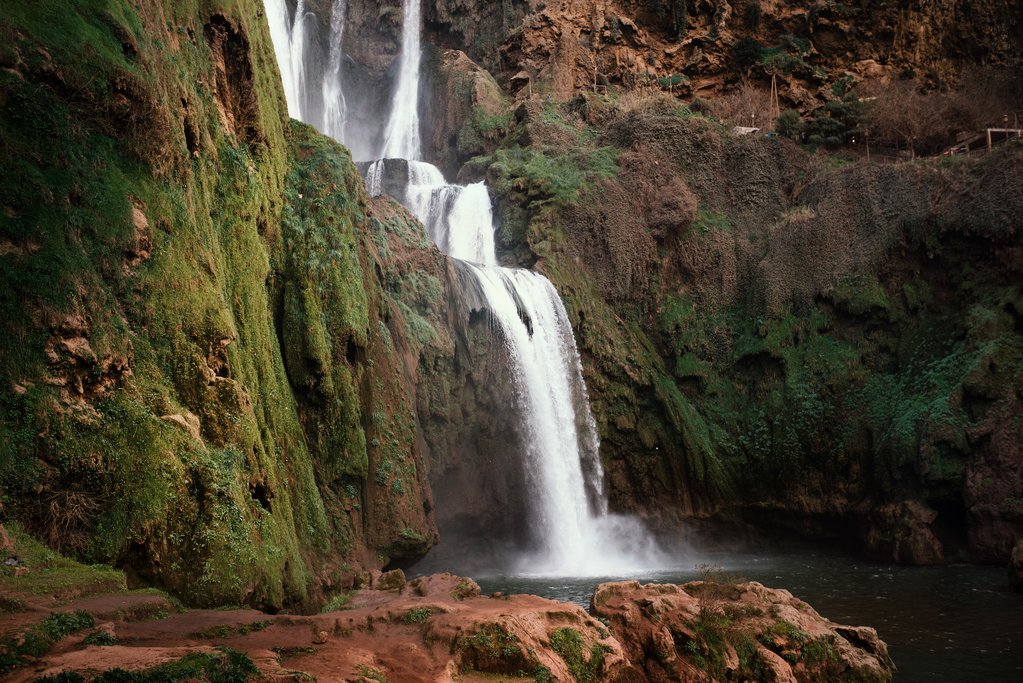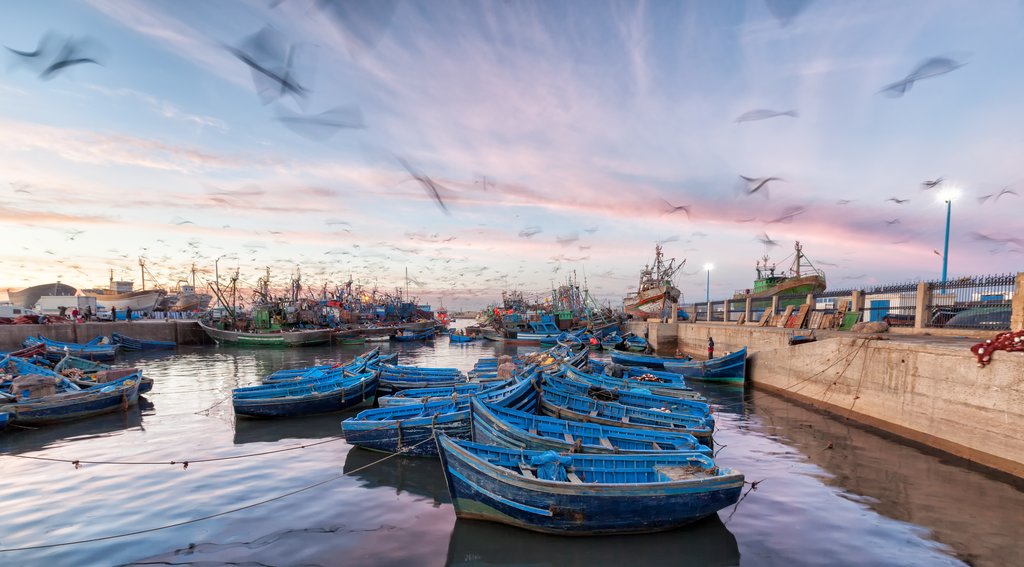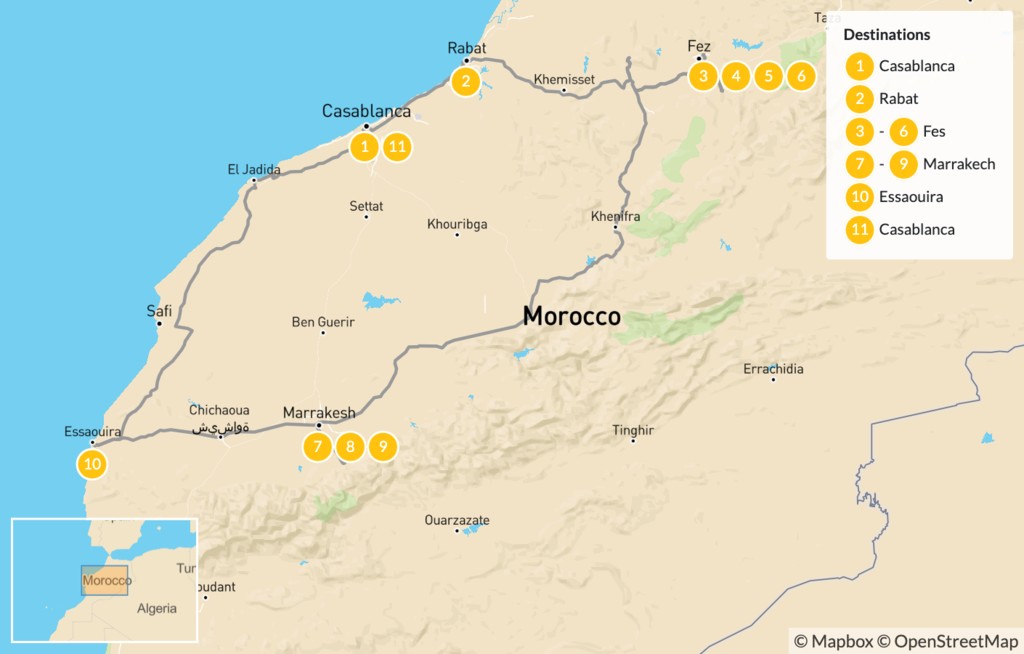Highlights
- Explore the Berber villages and traditional farm life of the Atlas mountains
- Discover the ancient Roman ruins of Volubilis
- Delight your tastebuds in a three-hour traditional food tour
- Peruse the souks and medinas of Morocco's charming imperial cities
- Hike to a stunning waterfall near Marrakesh
Brief Itinerary
| Day | Highlights | Overnight |
|---|---|---|
| Day 1 | Arrive in Casablanca | Casablanca |
| Day 2 | Transfer to Rabat, Visit the Town of Salé | Rabat |
| Day 3 | Transfer to Fes via Meknes & the Roman Ruins at Volubilis | Fes |
| Day 4 | Explore the Imperial City of Fes & its UNESCO Medina | Fes |
| Day 5 | Attend a Traditional Cooking Class, Relax in a Hammam | Fes |
| Day 6 | Day Trip to Ahinajen Berber Village | Fes |
| Day 7 | Transfer to Marrakesh via Beni-Mellal & the Atlas Mountains | Marrakesh |
| Day 8 | Explore Marrakesh, Evening Food Tour | Marrakesh |
| Day 9 | Day Trip to Ourika, Hike to a Waterfall | Marrakesh |
| Day 10 | Travel to Essaouira, Stop at an Argan Oil Farm | Essaouira |
| Day 11 | Transfer to Casablanca via the Atlantic Coast & Portuguese Ports | Casablanca |
| Day 12 | Depart Casablanca |
Detailed Itinerary
Day 1: Arrive in Casablanca

Welcome to Morocco! After arriving at the airport, a private driver will transfer you to your hotel. Get settled into your accommodation and prepare to explore the bustling imperial city of Casablanca. Start with a tour of the Hassan II Mosque. This exquisite mosque has the tallest minaret in the world and represents some of the best architecture in Morocco. The lavish interior features wood, marble, and carved stone, as well as ornate ceilings. As the only mosque open to the public to tour, it's certainly a must when visiting Casablanca.
After your tour of the mosque, meander the city's old town and stop for lunch at your leisure. There are many cafés and restaurants within the medina quarter. Then, continue your exploration with visits to Central Market, the Habous Quarter, or the Royal Palace.
Day 2: Transfer to Rabat, Visit the Town of Salé

Today you'll travel to Rabat, Morocco's capital city and home of the royal family. Upon arrival, you'll visit the Hassan Tower monument, which is one of the most magnificent buildings of the Almohad Dynasty. An abandoned project of the 12th century, the Hassan Tower is a minaret meant to be attached to Mohamed V's mosque and mausoleum, which were never completed. All that remains today is the red sandstone tower standing at 145 feet (44 m) and about 200 columns.
Enjoy lunch on your own. Your driver can provide you with a recommendation, although you'll find plenty of restaurants and cafés in the neighborhood around the tower.
In the afternoon, you'll head to the nearby city of Salé for a tour of the historic madrasa. Viewing the stunning architecture and Moroccan craftwork is a unique experience. You can also visit the Bab Antare and Bab Mellah, walled neighborhoods that divide the city. Tonight, enjoy dinner on your own with recommendations from your guide.
Day 3: Transfer to Fes via Meknes & the Roman Ruins at Volubilis

After breakfast, meet your driver to start today's journey to Fes. Your first stop is Meknes, a charming city with a smaller medina, allowing for a more leisurely pace without worrying about pushy shopkeepers. Your driver will lead you through the Ville Impériale area, where you can explore gardens and palaces, as well as the gate of Bab al-Mansour, the Mausoleum of Moulay Ismail, and the Royal Stables.
After enjoying Meknes, you'll head to Moulay Idriss, a hillside town that, from a distance, looks like a sitting camel. Founded by Moulay Idriss I in 789 after fleeing Mecca due to religious and tribal conflicts, it's the oldest town in Morocco and where the Idrisid Dynasty was founded. The town has the only round minaret in all of Morocco. Lunch is on your own here, with recommendations from your driver.
Your last stop before Fes is Volubilis. This UNESCO World Heritage Site contains Morocco's most well-preserved Roman ruins and makes for a nice break from driving. You can wander the massive complex with a guide, exploring large merchant homes with temples and colorful mosaics. Today ends in Fes—one of Morocco's four imperial cities—where you can relax and enjoy the night at your leisure.
Day 4: Explore the Imperial City of Fes & its UNESCO Medina

Your tour guide will meet you after breakfast to start your exploration in the Fes medina. This UNESCO-protected old quarter is full of charming alleyways and narrow roads. Your local guide will share hidden stories and show you secluded corners of the medina, allowing you to observe both the small details of daily life and the grandiosity of the madrasas and palaces. Your guide will help you see the local side of Fes, giving you plenty of recommendations for lunch and dinner.
In the afternoon, you'll enjoy the artisan side of Fes. The city is a hub of Moroccan crafts and arts, giving you the opportunity to meet artisans and learn about the history and importance of their trades. You'll visit tanneries and mosaic workshops to observe traditional crafting methods still in use today. Head back to your riad for a little reprieve. You can relax for the rest of the day or return to the streets of the medina and test your new knowledge of Fes.
Chat with a local specialist who can help organize your trip.
Day 5: Attend a Traditional Cooking Class, Relax in a Hammam

Enjoy your morning with a filling breakfast as you prepare for a delightful five-hour cooking class. In this class, you'll purchase all your ingredients in a nearby market, just like the locals. You'll then learn traditional Moroccan cooking methods and spices, prepare your four-course meal and enjoy it in the end.
After the cooking class, you'll have the afternoon free to explore more of this beautiful city by yourself or opt for a relaxing visit to a traditional hammam. Your experience will begin in a dry, warm room to relax and allow the body to acclimate to the heat before entering a sauna and then a steam room. Next, you'll receive a body scrub with black olive-oil soap known as Savon beldi (Moroccan black soap). Your hammam attendant will coordinate a series of scrubbing and rinsing to alleviate any rough skin and stress. You'll emerge from your experience feeling refreshed and energized.
Return to your accommodation to freshen up before heading out into the city for an evening at your own pace.
Day 6: Day Trip to Ahinajen Berber Village

Rise early as you'll start your morning visiting the Berber village of Ahinajen in the Middle Atlas mountains. You'll complete the journey in a local souk van or, as the locals do, in a pick-up truck. Upon arrival, you'll have lunch with a family local to the village. After lunch, head down the valley to observe and interact with the farmers working on their lands. Traditionally, women and children act as shepherds for the family livestock, creating interesting family dynamics. This experience is very eye-opening to the rural way of life in the Atlas mountains and a great way to interact directly with the local culture.
On the way back to Fes, you'll stop at the mausoleum of Sidi Bousghin. Here you'll enjoy a stunning panoramic view of the town of Sefrou and the snow-capped Middle Atlas mountains. Depending on the time, you can opt for dinner in either Sefrou or Fes.
Day 7: Transfer to Marrakesh via Beni-Mellal & the Atlas Mountains

After an early breakfast, you'll meet your driver for a long day of travel from Fes to Marrakesh. This eight-hour journey is quite scenic, passing through the Atlas mountains. Along the way, you'll visit a few historical Berber villages, as well as an almond-tree farm and the famous Barbary apes in the mountains. Enjoy a lunch break in the city of Beni-Mellal. After all the tranquility of the mountains, you'll be ready for the hustle, bustle, and clamor of vibrant Marrakesh.
After settling into your accommodation, head to the main square, Jemaa el-Fna square, which comes alive each evening with musicians, performers, snake charmers, games, food stalls, and more. If you want to enjoy the buzz from a distance, there are many cafés surrounding the square where you can sit and watch the show over a meal.
Day 8: Explore Marrakesh, Evening Food Tour

On your second day in Marrakesh, you'll meet your local guide for a walking tour of the city's stunning old medina, a UNESCO World Heritage Site. As you meander the narrow streets, enjoy the charming souk (marketplace) with its endless displays of djellabas (traditional clothing), brightly-colored babouches (sandals), intricately-designed lanterns, and mounds of exotic spices, plus the buzz of local life. Your energetic guide will entertain you with historical tales and stories of the medina and its souk, all kept within the city's rose-colored walls.
After lunch, head back to your accommodation for a bit of relaxation before your evening activities. Around 6 pm, you'll begin a three-hour guided food tour around the Marrakesh Medina, tasting local food and drinks.
Day 9: Day Trip to Ourika, Hike to a Waterfall

Your Ourika Valley day trip begins early in the morning after breakfast. Enjoy a short-yet-scenic drive from Marrakesh into the foothills of the Atlas mountains. The route curves along the valley of Ourika, entering through a succession of picturesque mountain villages. You'll continue your tour to Setti Fatma, a favorite weekend destination for many Moroccans. Well known for its beautiful streams, seven waterfalls, dramatic cliffs, and green valleys, this interesting region still practices a medieval tradition of agriculture. Enjoy a walk around the valley, taking in the views of green terraces and the surrounding Atlas mountains.
In the early afternoon, you'll enjoy a hike to the first of the waterfalls with your local guide. This is a great way to escape the bustle of city life and enjoy a reprieve in nature. After the hike, you'll enjoy lunch in a local restaurant with a beautiful view over the mountains.
You'll return to Marrakesh in the evening, where you'll have time to continue your exploration of the city and find a restaurant for dinner.
Day 10: Transfer to Essaouira, Stop at an Argan Oil Farm

After breakfast, you'll begin your travel to Essaouira, a town made popular by its excellent surfing beaches. The three-hour route passes over extensive, rolling plains with gorgeous views. As you approach the western seaboard of Morocco, you'll enter a unique forest. This is the only ecosystem where argan trees grow. A slight detour will take you to an association of local women that make argan oil, famed for its excellent health and beauty properties. Don't be surprised if you see goats grazing on the fruits of the argan trees, high in the branches. It's quite a sight!
Upon arrival in Essaouira, enjoy walking the impressive seawalls and discovering delights in the old medina area. Jewish heritage is very present in Essaouira, where one of the most well-preserved Jewish quarters in Morocco is located. It is a perfect example of a coexistent community and a very interesting place to explore.
The Essaouira harbor is the commercial heart of town and a must-see destination for anyone wanting to understand the local culinary culture. Every morning, countless fishermen haul their catches ashore to sell in the nearby market. Just outside of the harbor, you'll find many unassuming food stalls where you can eat some of the freshest fish for lunch, grilled or fried. You can order fish straight from the stalls or eat the traditional way by buying your fish in the nearby market and commissioning a cook to grill it for a small fee.
After lunch, settle into your accommodation in a luxury riad. Return to the medina quarter to enjoy Essaouira's evening buzz and wonderful nightlife.
Day 11: Transfer to Casablanca via the Atlantic Coast & Portuguese Ports

Enjoy a leisurely breakfast before departing for Casablanca. Today's route follows the scenic coast and passes through two Portuguese fortified cities along the way. The first stop is the city of El Jadida, where you'll tour the hauntingly beautiful Portuguese cistern. You can also walk the ramparts and visit the Church of the Assumption.
Next is Azemour, which has inspired many Moroccan artists over the decades, some of whom have chosen to live here. Life in Azemour is still quite traditional despite its close proximity to the cosmopolitan art market of Casablanca. A crumbling 16th-century medina squeezed between the Oud Er-Rbia (Mother of Spring River) and the ocean provides plenty of artistic inspiration.
Upon arrival in Casablanca, settle into your accommodation and head out for a quick lunch. In the afternoon, you might like to check out the Hassan II Mosque if you didn't get a chance on your first day or stroll the Boulevard de la Corniche. There are plenty of delicious restaurants in Casablanca's medina quarter, which buzzes with a different kind of energy in the evenings.
Day 12: Depart Casablanca

It's time to say goodbye to beautiful Morocco. Depending on the time of your departure flight, you may be able to do some last-minute sightseeing in Casablanca or enjoy tea at one of the traditional cafés. When the time comes, you'll head to Casablanca's Mohammed V International Airport for your flight.
More Great Morocco Itineraries
Looking for more inspiration for your trip to Morocco? Check out these other Morocco itineraries, explore different ways to spend 12 days in Morocco, or discover the best time to visit Morocco.


